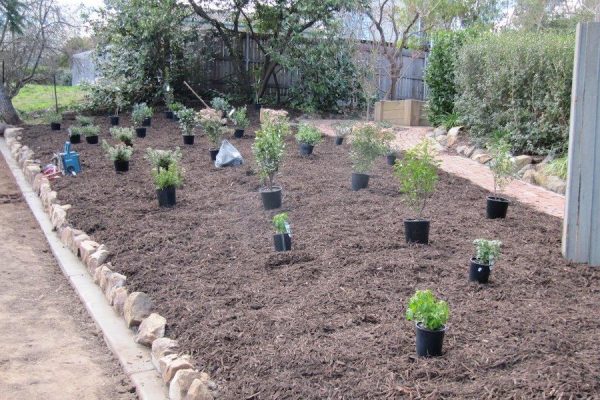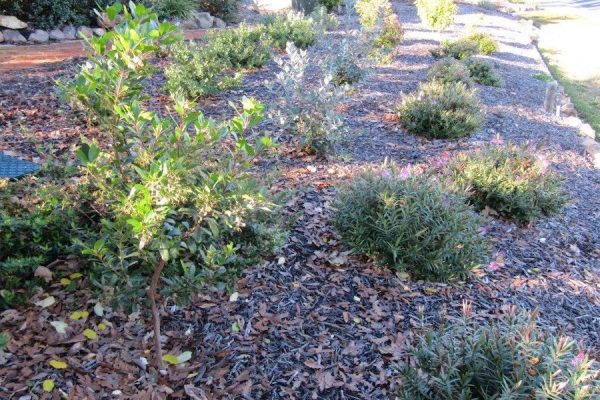
Garden writer CEDRIC BRYANT has some tips to laying out a new garden.
WHEN establishing a new garden, the “grow” of plants is often underestimated and, like trees, shrubs and perennials need plenty of space.

Ground preparation is vital, but soil can be improved quite easily and every bit of extra effort will pay dividends.
If soil is heavily compacted, usually on new home sites with builders’ trucks, it may pay to get a landscaper with a Bobcat to break up the surface.
If there’s no access for a Bobcat, a mini version is a Dingo, which is just over a metre wide and the operator stands on the rear of the machine.
Rotary hoes are an alternative, although I’m not a fan because the flat tines dig only about 100mm deep and, below that, tend to pack the soil, especially if it’s clay. This can actually slow root growth.

Apply Multicrop liquid “Ground Breaker”, which penetrates deep into the soil breaking up any clay. Gypsum is an alternative but, unlike the liquid ground breaker, it doesn’t penetrate deeper nor spread out sideways. The addition of any organic material, manure or leaves will help.
Next, draw a simple plan divided into one-metre squares. Then do the research on the spread of the plants. Before planting, it’s a good idea to place the plants on the ground and get an idea of how they will look.
Illustrated here is a garden I prepared for a client in Melba. All plants were watered in with Maxicrop Seaweed Plant Nutrient, to specifically promote root growth. Drip irrigation was installed at planting time.
Twelve months later, the plants were leaping out of the ground, being fed regularly with Neutrog Seamungus, a certified organic combination of seaweed and chook poo.

WITH the ever decreasing size of suburban gardens, there is a constant demand for low-growing, evergreen, flowering shrubs.
As an example, Escallonias, originally from the Andean region of South America, have to be tough to survive there! “Red Knight” is a dwarf variety with glossy evergreen leaves and rich, cerise flowers.
It grows to 1.5 metres tall, although can be clipped after flowering to keep it to one metre as a low hedge. Similarly, “Pink Pixie” (also sold under the label of “Hedge with an Edge”), which grows naturally to only 80 centimetres.
Then there’s the large Osmanthus family, which grows to more than three metres. For smaller gardens, “Heaven Sent’s” tubular white fragrant flowers are set off against its dark green leaves. While this can grow up to 1.5 metres tall, I have kept ours as a dwarf hedge to just one metre tall and half a metre wide. Osmanthus originates mainly in China, where the climate can range from drought to heat, but certainly has no problem with our climate here.
NO excuses, get gardening! Here are some suggestions that will keep you fit and well:
- It is not too late to “hard” prune Buddleia, reducing the height to one metre from the ground.
- Tidy the strawberry bed, removing competing weeds and old leaves, which are a haven for snails.
- Move soil and mulch off the top of iris rhizomes. To flower well, these must be baked by the sun.
- Get on with mulching, making sure the ground is wet before applying.
- Prune frost-damaged plants to encourage new growth.
- Cut back agapanthus leaves to encourage sun to promote flowers.
- Daffodil leaves can be cut back to ground level six weeks after flowering.
- Keep whipper snippers well away from the stems and trunks of all shrubs and trees. They are real killers for ring-barking plants.
- Prune wisteria back to three nods (leaf joints) on all long shoots.
- A last reminder to check dripper systems. I suggest raising the lines above the ground to inspect, but still under mulch. Most probably, mulch will need to be renewed before the heat arrives.
- It is time to remove primulas, violas and pansies, and replace them with petunias.
This is a “best-of” compilation of Cedric’s columns over the past 10 years.
Who can be trusted?
In a world of spin and confusion, there’s never been a more important time to support independent journalism in Canberra.
If you trust our work online and want to enforce the power of independent voices, I invite you to make a small contribution.
Every dollar of support is invested back into our journalism to help keep citynews.com.au strong and free.
Thank you,
Ian Meikle, editor




Leave a Reply